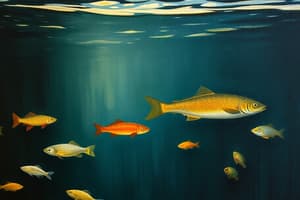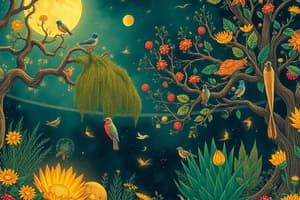Podcast
Questions and Answers
What happens when energy is captured and stored in a form organisms can use?
What happens when energy is captured and stored in a form organisms can use?
It moves from the 'eaten' to the 'eater' when one organism eats another.
How are primary producers and consumers linked in ecosystems?
How are primary producers and consumers linked in ecosystems?
They are linked through feeding relationships.
How does energy flow through an ecosystem?
How does energy flow through an ecosystem?
In a one-way direction, from primary producers through various consumers.
What is a food chain?
What is a food chain?
Give an example of a short food chain in Gorongosa National Park.
Give an example of a short food chain in Gorongosa National Park.
What are primary producers in aquatic ecosystems?
What are primary producers in aquatic ecosystems?
What do zooplankton eat in aquatic ecosystems?
What do zooplankton eat in aquatic ecosystems?
How many steps are big marine animals often from primary producers in aquatic ecosystems?
How many steps are big marine animals often from primary producers in aquatic ecosystems?
Why are feeding relationships in most ecosystems more complicated than a simple chain?
Why are feeding relationships in most ecosystems more complicated than a simple chain?
What is a food web?
What is a food web?
Explain what a food web is and how it differs from a food chain.
Explain what a food web is and how it differs from a food chain.
What role do decomposers and detritivores play in food webs?
What role do decomposers and detritivores play in food webs?
Why do most producers die without being eaten?
Why do most producers die without being eaten?
What is the detritus pathway in a food web?
What is the detritus pathway in a food web?
What is the role of decomposers in nutrient cycling?
What is the role of decomposers in nutrient cycling?
How do short-term natural disturbances, like floods, impact food webs?
How do short-term natural disturbances, like floods, impact food webs?
What are some examples of long-term human-caused disturbances that can transform ecosystems?
What are some examples of long-term human-caused disturbances that can transform ecosystems?
What is a trophic level in a food chain or food web?
What is a trophic level in a food chain or food web?
What is an ecological pyramid and how does it illustrate trophic levels?
What is an ecological pyramid and how does it illustrate trophic levels?
What is the main reason why only a small portion of energy stored in one trophic level is available to organisms at the next level?
What is the main reason why only a small portion of energy stored in one trophic level is available to organisms at the next level?
Flashcards are hidden until you start studying
Study Notes
Energy Flow in Ecosystems
- When energy is captured and stored in a form organisms can use, it flows through the ecosystem, supporting life.
Primary Producers and Consumers
- Primary producers (e.g., plants, algae) convert sunlight into energy through photosynthesis, which is then consumed by primary consumers (herbivores).
- Primary producers and consumers are linked in ecosystems, with producers forming the base of the food web.
Energy Flow and Food Chains
- Energy flows from one organism to another through consumption, forming a food chain.
- A food chain is a series of organisms each consuming the previous one, with energy transferred from one trophic level to the next.
- Example of a short food chain in Gorongosa National Park: grass → impala → leopard.
Aquatic Ecosystems
- Primary producers in aquatic ecosystems include phytoplankton, seaweed, and seagrass.
- Zooplankton in aquatic ecosystems eat phytoplankton.
Complexity of Feeding Relationships
- Feeding relationships in most ecosystems are more complicated than a simple chain, involving multiple predators and prey.
- A food web is a network of interconnected food chains, showing the complex feeding relationships in an ecosystem.
- Decomposers and detritivores play a crucial role in food webs, breaking down organic matter and recycling nutrients.
Decomposers and Detritivores
- Most producers die without being eaten and enter the detritus pathway, which decomposers and detritivores break down, releasing nutrients back into the ecosystem.
- Decomposers play a key role in nutrient cycling, releasing essential nutrients for other organisms.
Disturbances and Ecosystems
- Short-term natural disturbances like floods can impact food webs by disrupting energy flow.
- Long-term human-caused disturbances (e.g., habitat destruction, climate change) can transform ecosystems, altering feeding relationships and nutrient cycling.
Trophic Levels and Ecological Pyramids
- A trophic level represents a level in a food chain or web, with producers at the base and top predators at the apex.
- An ecological pyramid illustrates trophic levels, with each level supporting fewer organisms than the one below it.
- The main reason only a small portion of energy stored in one trophic level is available to organisms at the next level is due to energy loss as heat and incomplete transfer.
Studying That Suits You
Use AI to generate personalized quizzes and flashcards to suit your learning preferences.




